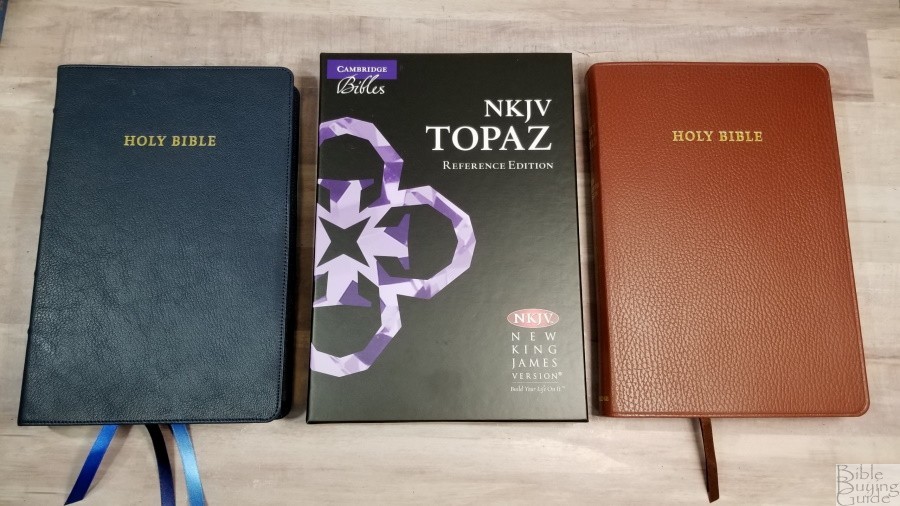
The NKJV Topaz is Cambridge’s newest addition to the Topaz line. Following the design of the ESV, it presents the NKJV text in a large print, verse-by-verse setting with preaching, teaching, and public reading in mind. It makes a great companion to the Clarion, Pitt Minion, and Wide Margin editions. It’s available in black, blue, or green goatskin and black or brown calf-split. I’m reviewing the brown calf-split, ISBN 9781108965361, and the blue goatskin, ISBN 9781108949835, both made in the Netherlands by Royal Jongbleod, and designed and typeset by 2K/Denmark.
Cambridge provided a discount for the brown Bible and loaned me the blue Bible in exchange for an honest review. I was not required to give a positive review, only an honest one. All opinions are my own.
_________________________________________________________
This book is available from (contains some affiliate links)
_________________________________________________________
Table of Contents
- Video Review
- Cover and Binding
- Paper
- Typography
- References
- Presentation and Family Records
- Concordance
- Maps
- Comparisons
- Conclusion
Video Review
Cover and Binding
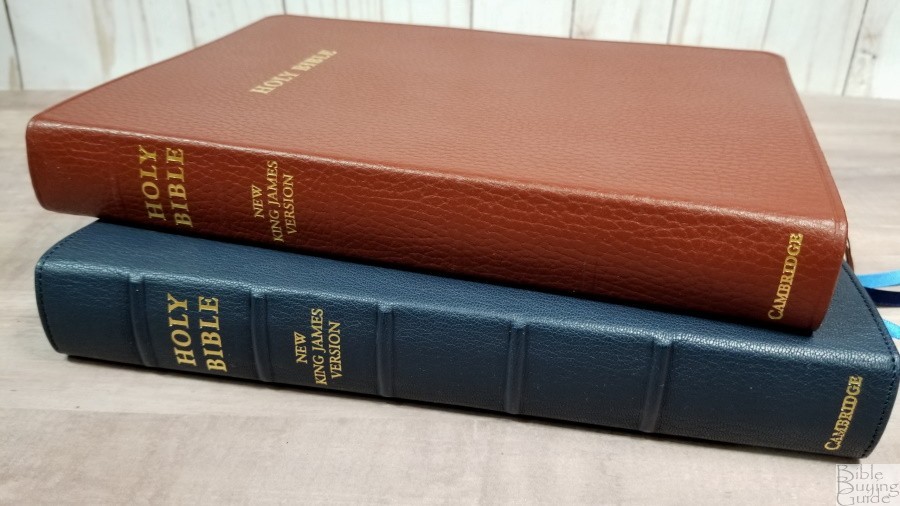
I’m reviewing the blue goatskin and the brown calf-split. Let’s look at each one independently and see what’s different between them.
Blue Goatskin

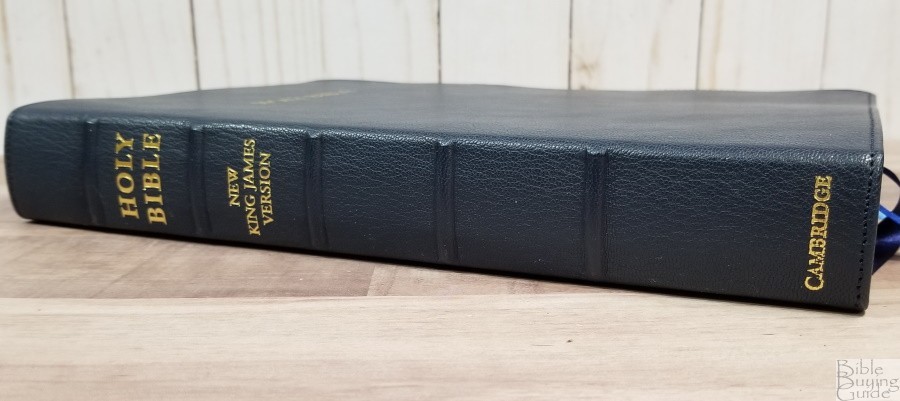
The blue goatskin has a smoother grain than I’ve seen in most Cambridge Bibles, which is the opposite of the ESV Topaz in black goatskin. The grain looks natural. I like the look and feel of the grain. It has perimeter stitching and a 1/4″ yapp. The front has HOLY BIBLE printed in gold. The spine has HOLY BIBLE, NEW KING JAMES VERSION, and CAMBRIDGE printed in gold. The spine also has 5 raised spine ribs.


The liner is edge-lined calfskin. The edge-lined tab is a touch stiff out of the box. It did have trouble staying open in Genesis, but this Bible is on loan, so I didn’t break it in or use it enough much. The text-block is Smyth sewn.

It has three double-sided satin ribbons in various shades of blue. They’re long enough to pull to the corner to open the Bible easily. They’re 3/8″ wide. the head/tail bands are blue and white. The overall size is 6 5/8 x 9 7/8 x 1 1/4″. It weighs 2lbs, 5.8oz.

It’s flexible, but not too floppy. I had no trouble carrying it, but I did have a little bit of trouble holding it in one hand to read. I preferred to read from the calf-split edition because it lays flatter.
Brown Calf-split
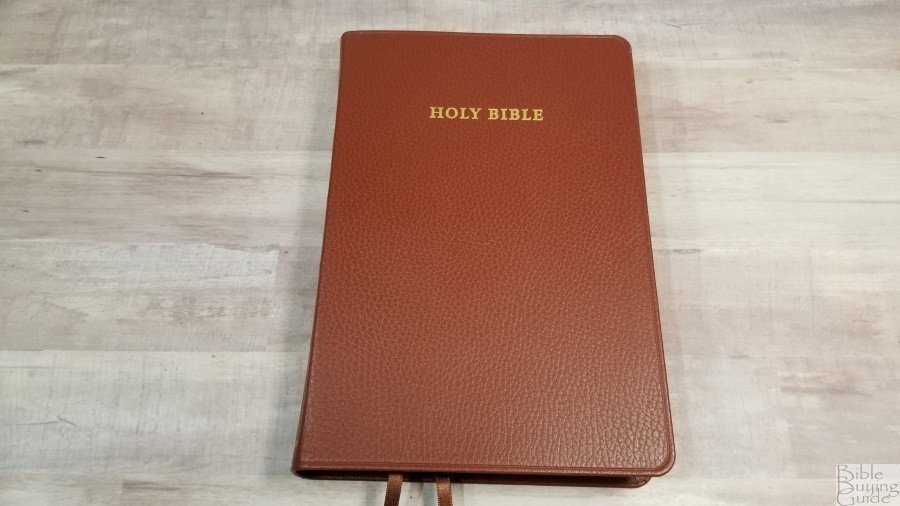

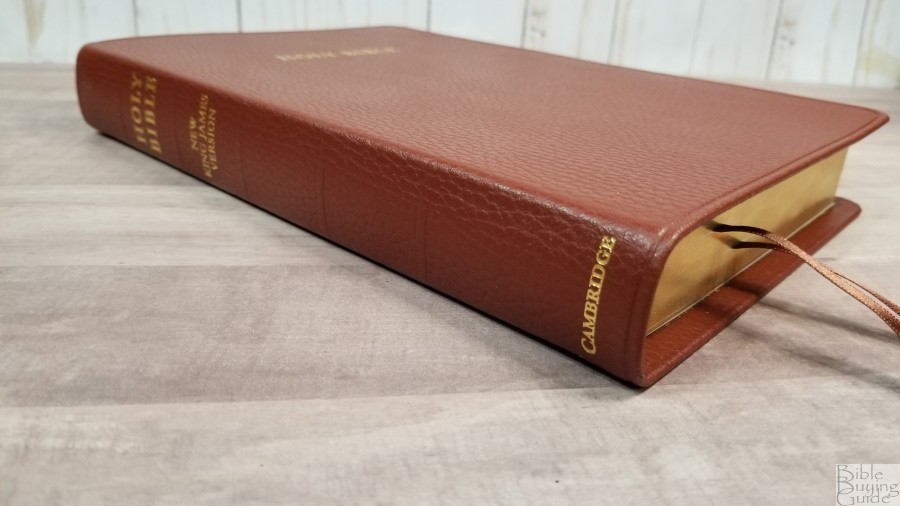
The brown calf-split looks more like mahogany than brown. I love this color. Like all calf-split editions from Cambridge, it’s stamped with a pebbly grain that looks and feels natural. It’s indented around the perimeter. The front has HOLY BIBLE printed in gold. The spine has HOLY BIBLE, NEW KING JAMES VERSION, and CAMBRIDGE printed in gold. The spine also has 5 rib indications. It has a 3/8″ yapp.

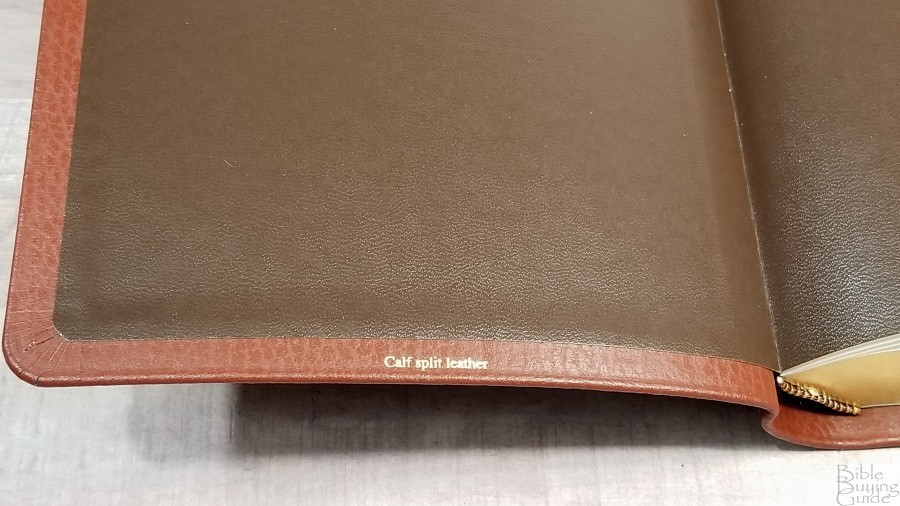
The liner is brown pasted-down vinyl. The text-block is sewn. It has no trouble staying open on any page. The stiffness of the cover and liner makes it easy to hold in one hand to carry and read.

It has two brown 1/4″ double-sided satin ribbons. They’re long enough to pull to the corner to open the page easily. The head/tail bands are brown and gold. They help complete the elegant look of this Bible. The overall size is 6 3/4 x 9 15/16 x 1 1/4″. It weighs 2lbs, 6.3oz.
Paper
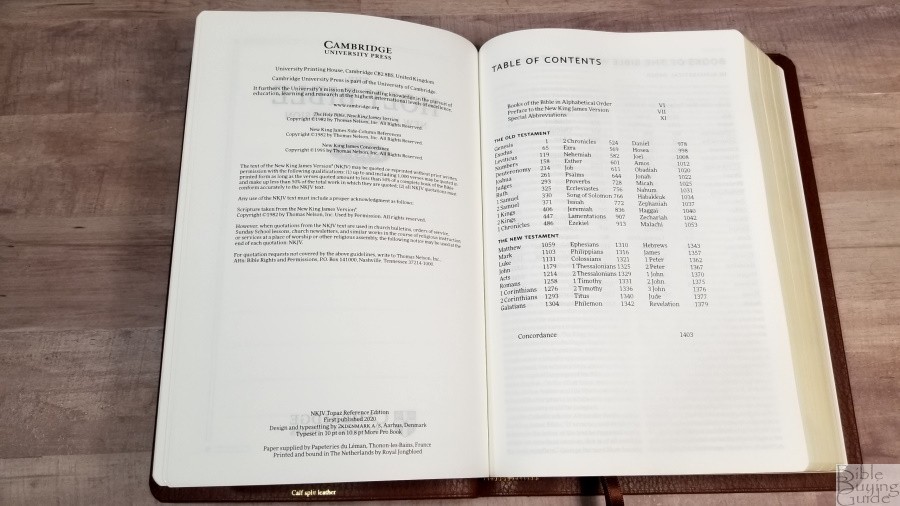
The paper is 28gsm Indopaque by Papeteries du Leman, Thonon-les-Bains, France. This is the same premium paper that’s used in many premium Bibles such as the Turquoise, goatskin Clarion, Pitt Minion, Concord, Quentel, Personal Size Quentel, etc. It’s ivory in color and highly opaque. I love this paper for reading. It’s smooth to the touch. I had no issues separating it with my fingers. It has 11 pages in the back that can be used for notes. The blue goatskin edition is art-gilt with blue under gold. The calf-split edition is gold-gilted. I love the look of art-gilt, but it does get damaged and show wear easily. I find regular gold-gilt easier to use because I’m not as worried about keeping it pretty.
Typography
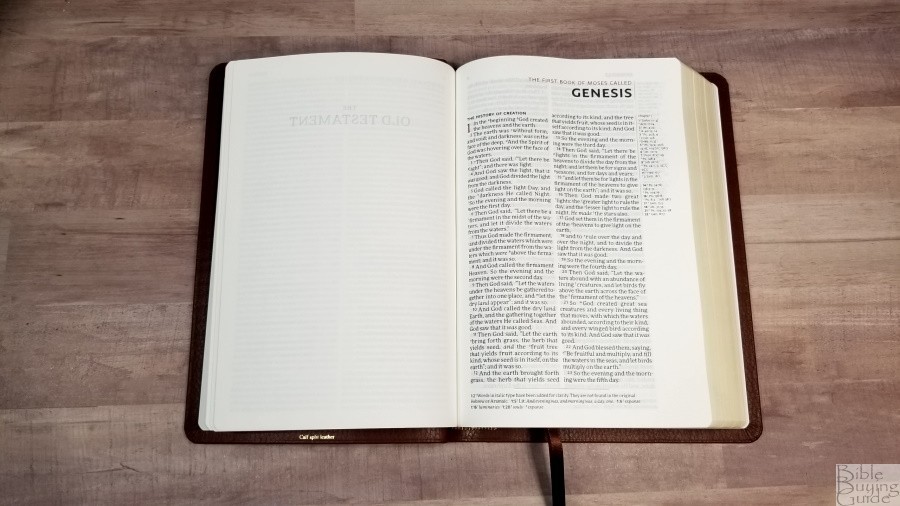
The NKJV text is presented without its standard formatting in a double-column verse-by-verse layout. Each verse is indented. Verses that continue the sentence from the previous verse start with a lower-case letter. There are no paragraph markers. It includes the standard NKJV section headings in bold all-caps. The lead-in to the book names, verse numbers, chapter number, and chapter title in the references are in red. Section headings, book names, and all reference and footnote keys are black. The header shows the book name and chapters in the outer margin and the page number in the inner margin. Cross-references are placed in the outer margin and footnotes are placed in the footer.
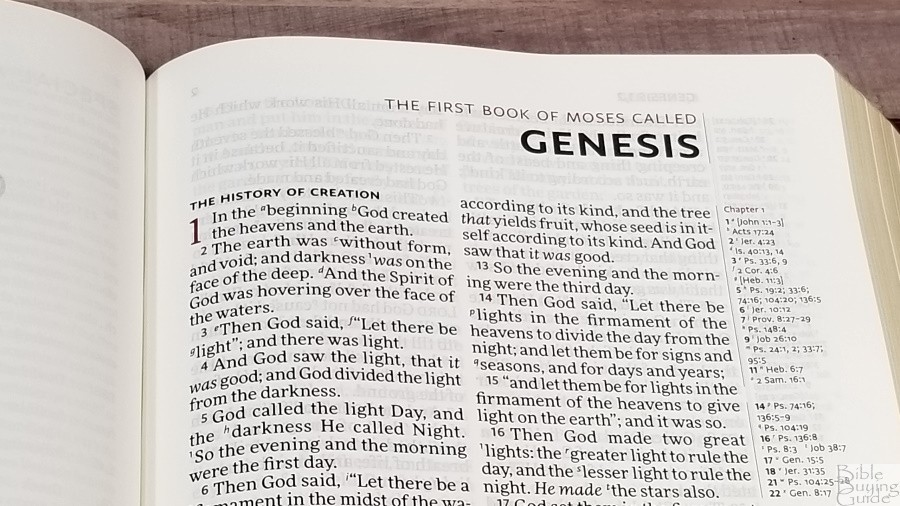
The layout was designed and typeset by 2K/Denmark using a 10-point typeface called More Pro Book. This is a red-letter edition. Both the black and the red are a dark semi-bold, and both are consistent throughout. The footnote and reference keys are superscripts. I found them large enough to see and small enough that they don’t cause too many unnatural pauses when preaching.
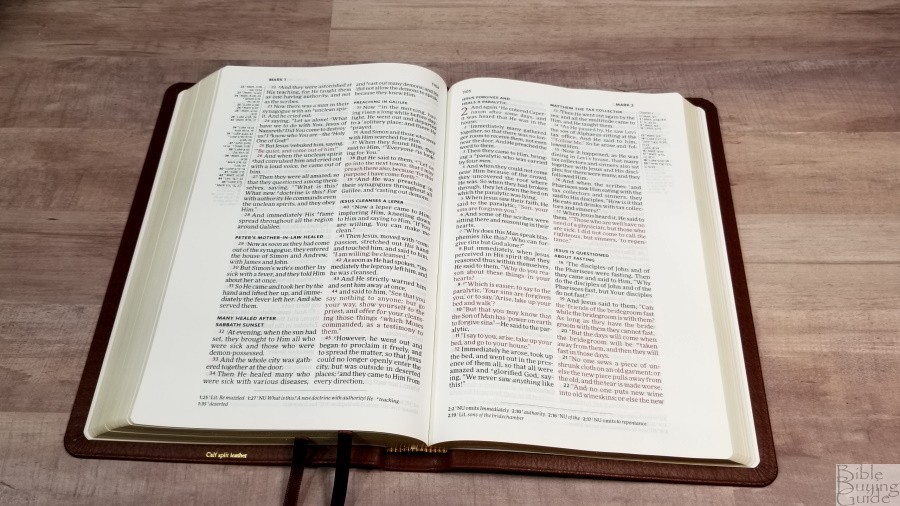
It has around 6-8 words per line. It has enough space between the words and the lines to be comfortable to read. It was slow-printed with line-matching, meaning that the lines are printed in the same location on both sides of the page. This greatly reduces show-through and improves readability. It has extra space in the inner margin to bring the text out of the bend and onto the flat part of the page. The text just starts into the bend. The fact that the spine is only 1.25″ helps this a lot.

Cross-references are placed in the outer margin starting at the top of the page. They’re separated from the text with a line. This design keeps all four columns of text together, keeping you from having to jump across the non-biblical text to continue reading. One advantage of this is it has a lot of empty margin space that’s good for writing notes. Having the references and footnotes separate makes them easier to find.
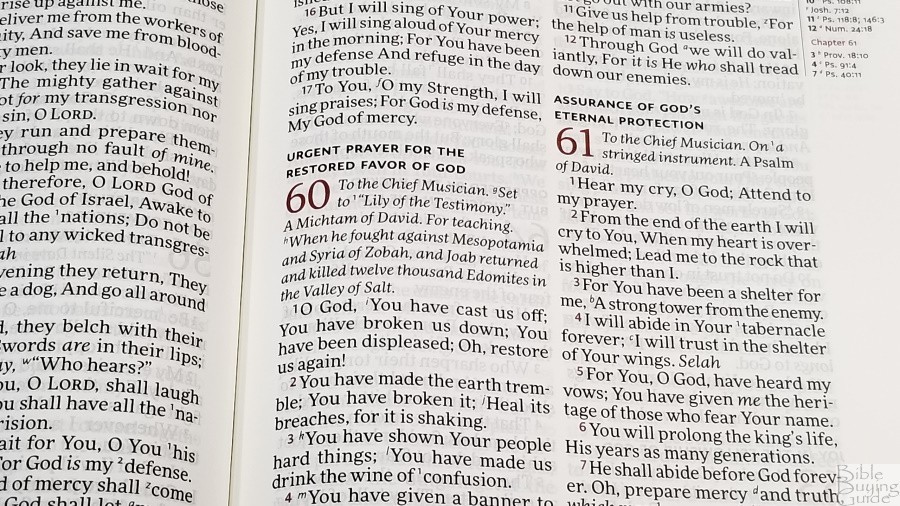
One thing that does stand out as odd is in poetry. The standard NKJV setting starts poetic breaks on a new line and each line starts with an upper-case letter. They’ve retained the upper-case letters, but not the poetic breaks. Some might prefer preaching from this layout instead of a standard poetic layout, but I find the upper-case letters in the text to look odd. The problem with v-b-v for me is that nothing stands out and you can’t identify the type of text at a glance. I’d prefer to see a poetic setting and letters indented even in a verse-by-verse layout. My guess is the columns needed more words per line to make this work.
References and Footnotes
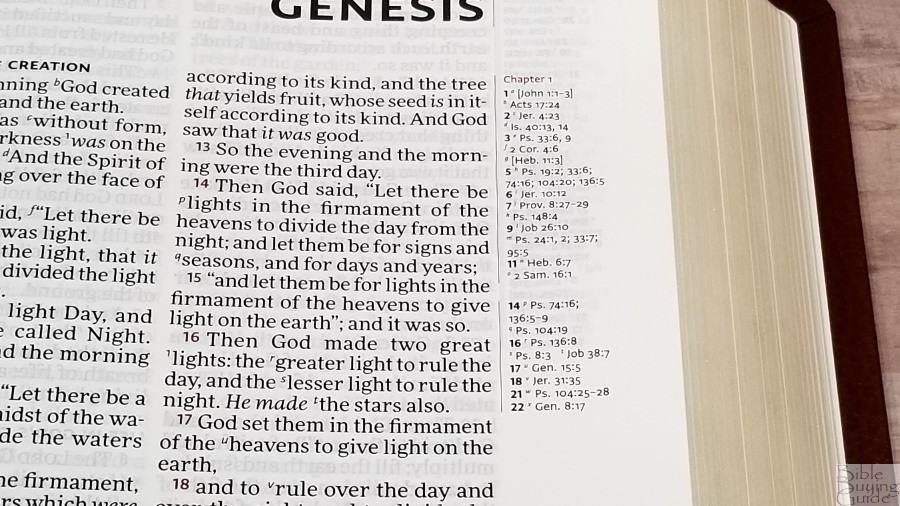
Cross-references are placed in the outer margin to keep the text on both sides of the page together. Those at the top are for the inner column, and those at the bottom are for the outer column. They’re separated from the text by lines. The pilot verse in the margin is bold. The cross-references cover both words and themes.
It has fewer references than the NKJV Pitt Minion and Clarion. There are enough to help with study and sermon prep, but I’d like to see it have the same number of references as the Clarion. Since it has the outer margin dedicated to the references, I’d like to see the margin filled up. The extra space can be used to add your own references, and I’d guess you’ll need to if this is your primary reference Bible. Fortunately, there are a few references in the footnotes.
Here are a few examples of references to help you compare:
- Genesis 1:1 – John 1:1-3; Acts 17:24
- Deuteronomy 6:4 – 1 Cor 8:4, 6
- Isaiah 9:6 – Luke 2:11; John 3:16; Matt 28:18; Judg 13:18; Titus 2:13; Eph 2:14
- Matthew 28:19 – Mark 16:15; Luke 24:47
- Mark 12:29 – Deut 6:4, 5
- John 1:1 – 1 John 1:1; Rev 19:13; John 17:5; 1 John 1:2; 5:20
- John 3:16 – Rom 5:8; Is 9:6
- Acts 2:38 – Luke 24:47
- Romans 10:9 – Luke 12:8
- 1 John 1:1 – John 1:1; John 1:14; 2 Pet 1:16; Luke 24:39; John 1:1, 4, 14
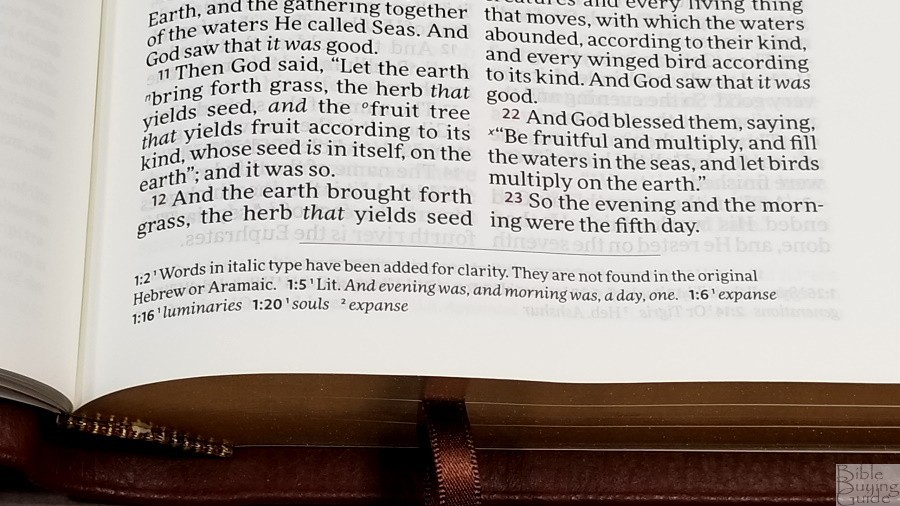
All of the NKJV translation footnotes are included. Footnotes provide explanatory notes, alternate translations, cross-references, NT citations of OT passages, textual variants, etc. The textual variants identify the manuscripts with the variant readings. This is one of the strengths of the NKJV in my opinion. I’m glad to see them included. I find them useful for personal study and sermon prep as they give insights into the text.
They are placed in the footer and are separated from the text by a line. They’re printed in a larger font than the references. I like that the footnotes are separated from the references. This helps make a cleaner design and makes the references and footnotes easier to find.
Presentation and Family Records
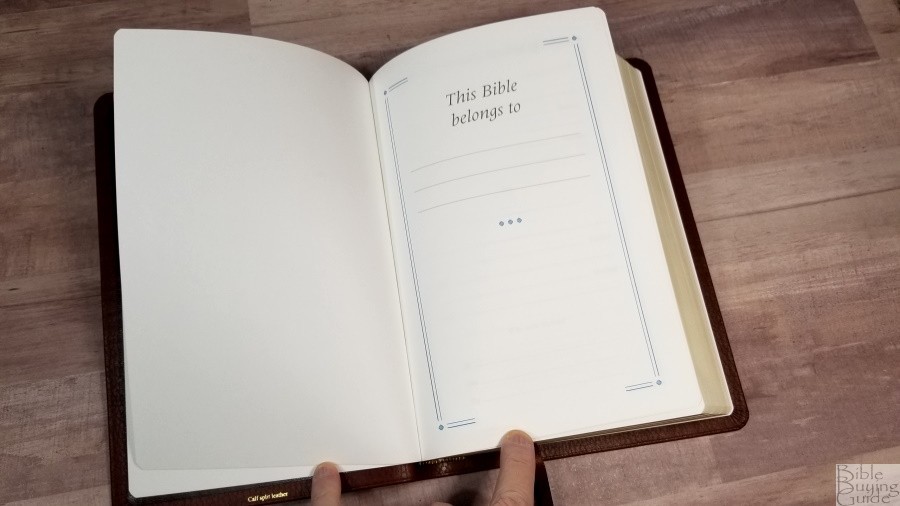
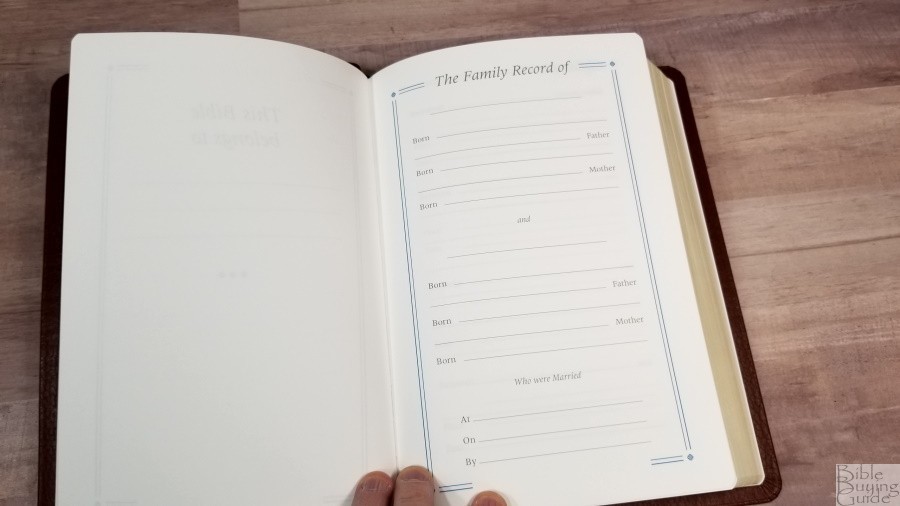
In the front are several pages for records printed on thick, non-glossy paper. It includes a page to show who the Bible belongs to, the family record of the husband and wife, children, marriages, grandchildren, and deaths. There are a few blank pages before the family pages. All of this thick paper helps give the Bible structure, so I’m glad to see it included.
Concordance
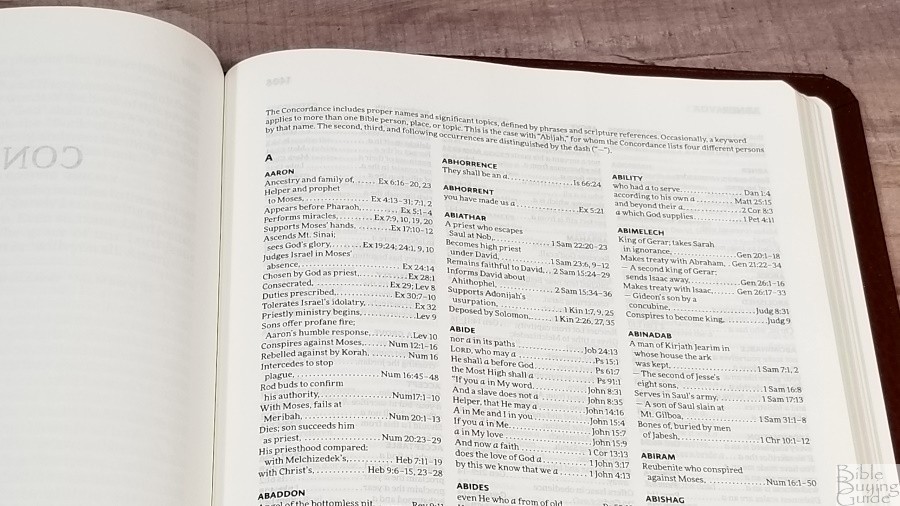
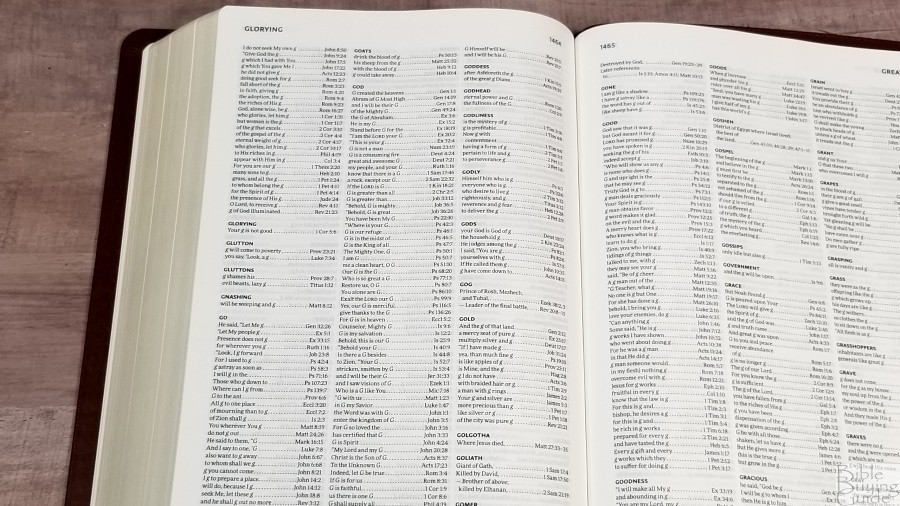
The concordance is 155 pages with 3 columns per page. It includes proper names and significant topics. Dashes are used to indicate when a keyword applies to a different person, place, or topic. It has lots of entries. This is a lot larger concordance than the one used in the Clarion. It’s a good concordance for study and sermon prep.
Sample entries include:
- Christ – 33
- Christian – 2
- Christians – 1
- Christs – 1
- Faith – 56
- Faithful – 26
- Faithfulness – 9
- Faithless – 2
- God – 70
- Goddess – 2
- Godhead – 2
- Godliness – 6
- Godly – 6
- Gods – 7
- Praise – 38
- Praised – 6
- Praises – 5
- Praiseworthy – 1
- Praising – 3
- Pray – 23
- Prayed – 3
- Prayer – 21
- Prayers – 9
Maps
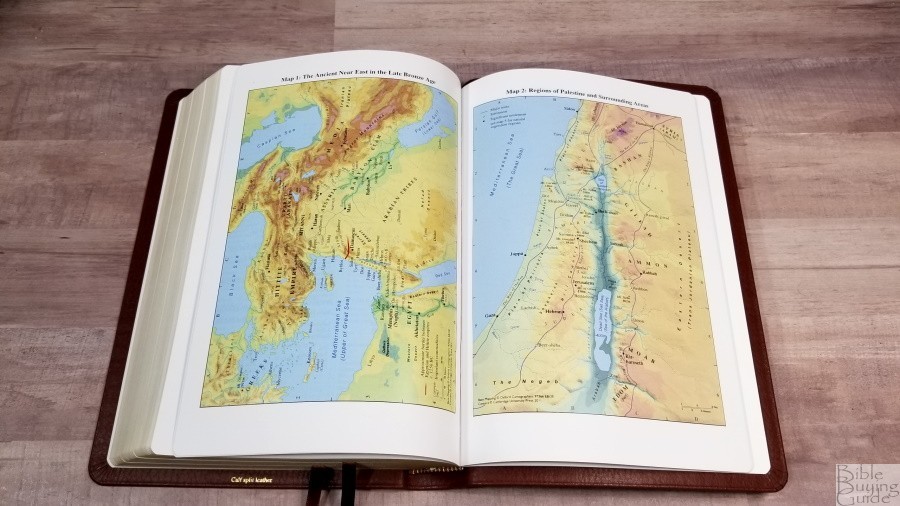
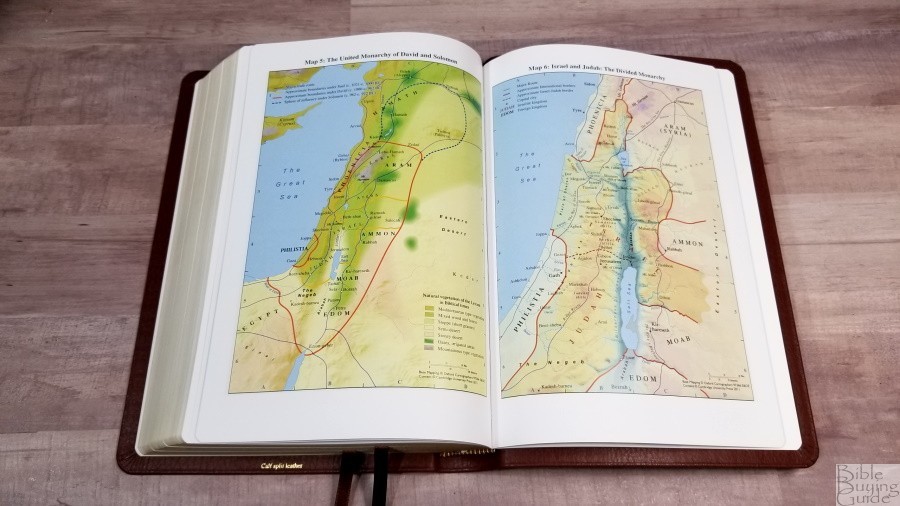

In the back are 15 pages of maps on thick semi-glossy paper. They are bright and colorful and they’re highly detailed. They include borders, import commodities, dates, routes, passes, settlements, distance, topography, mountains, cities of refuge, cities, tribes, vegetation, kingdoms, battle sites, satrapy, city walls, city gates, older city walls, seven Churches of Asia, etc.
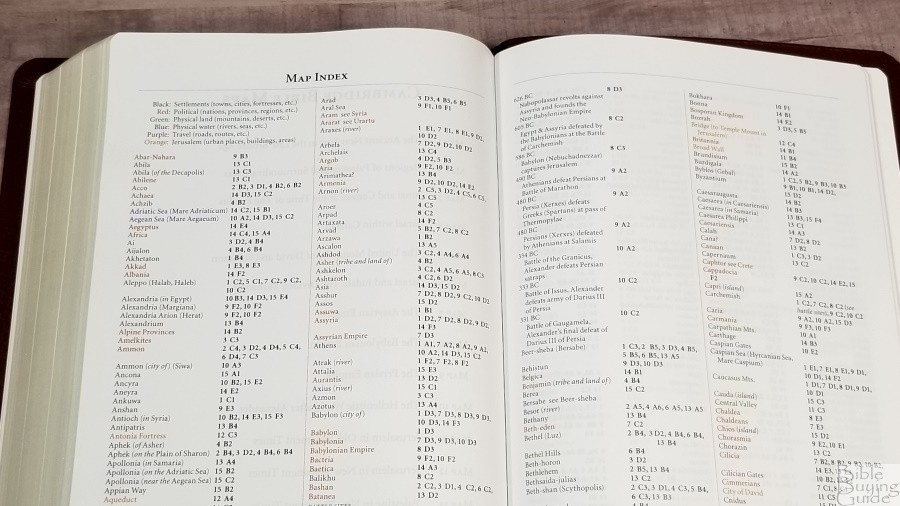
It also includes an 8-page color-coded index to maps. The index is printed on the same paper as the maps. They identify settlements, political (nations, provinces, and regions), physical land, physical water, travel, and Jerusalem. I’m always glad to see a map index included and I find the Cambridge color-coded index to be one of the best available.
Maps include:
- The Ancient Near East in the Late Bronze Age
- Regions of Palestine and Surrounding Areas
- Sinai and Canaan at the Time of the Exodus
- Israel within Canaan
- The United Monarchy of David and Solomon
- Israel and Judah: The Divided Monarchy
- The Assyrian Empire
- The Babylonian Empire
- The Persian Empire
- The Hellenistic World after Alexander
- Jerusalem in Old Testament Times
- Jerusalem in New Testament Times
- Palestine in New Testament Times
- The Roman Empire
- The Eastern Mediterranean in the First Century AD
Comparisons
Here’s how the Cambridge Topaz compares to a few similar Bibles.
ESV CalfskinTopaz

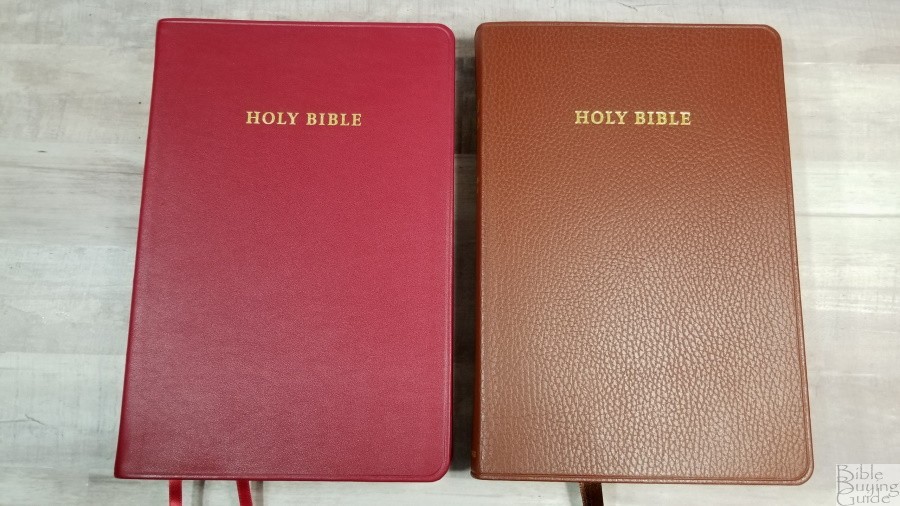
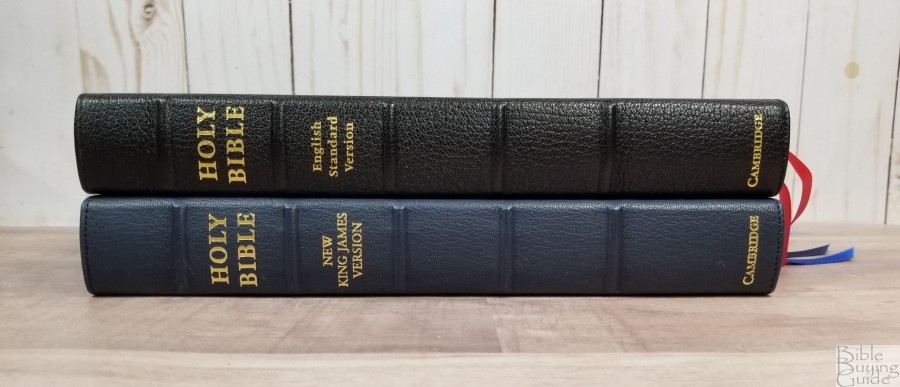
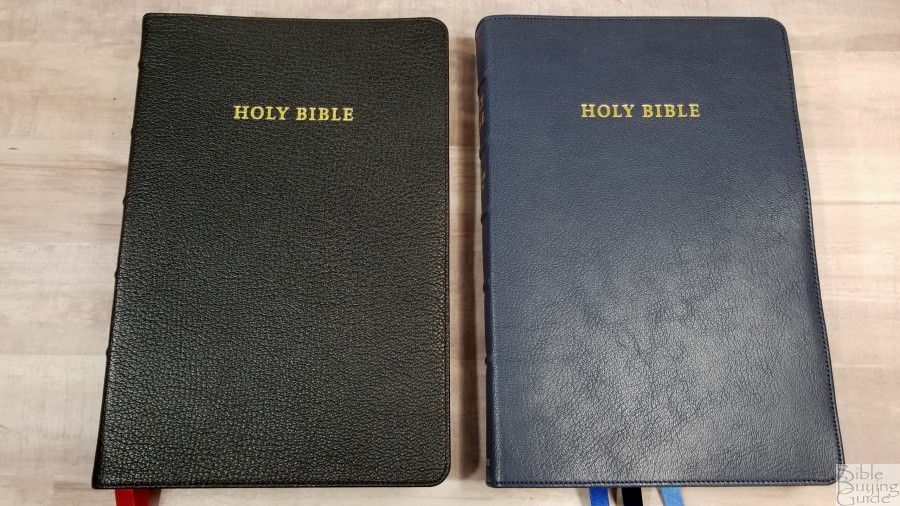
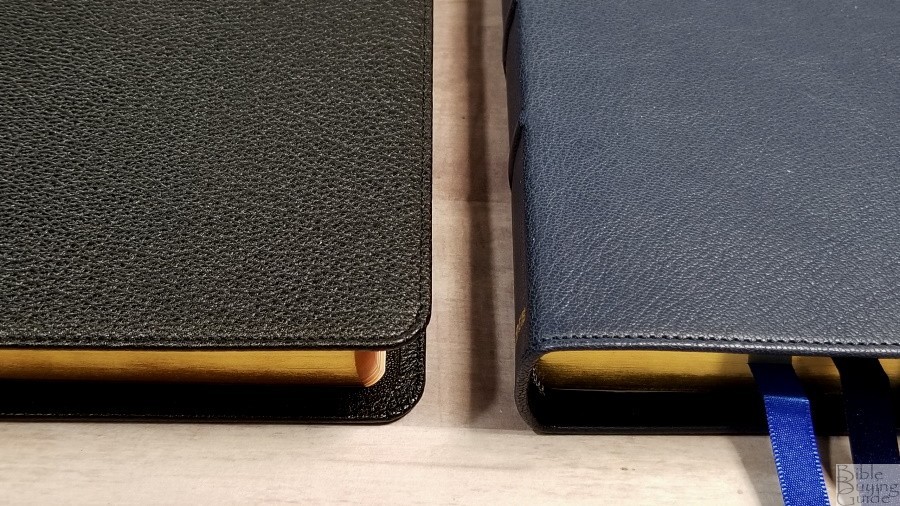
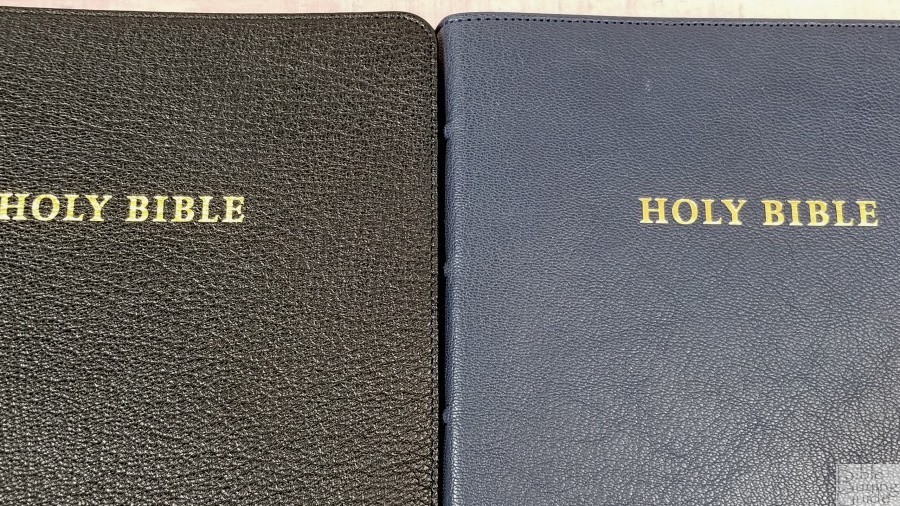
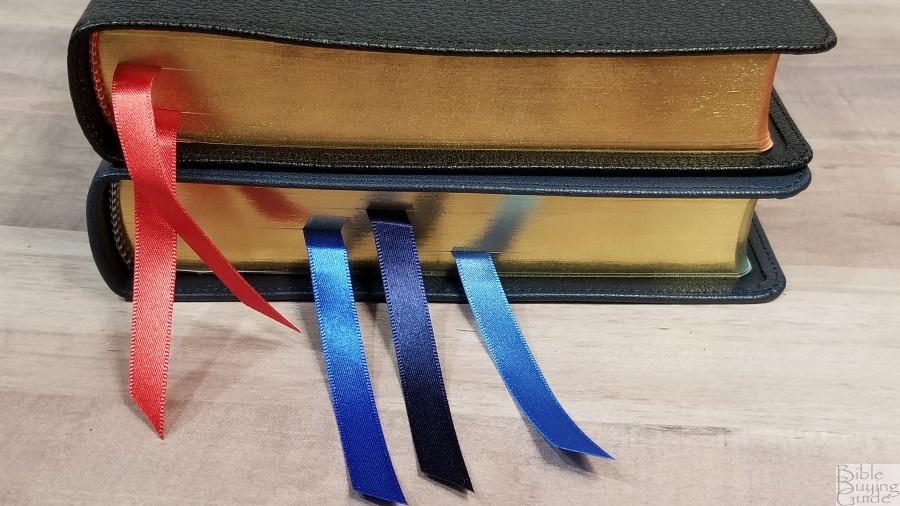
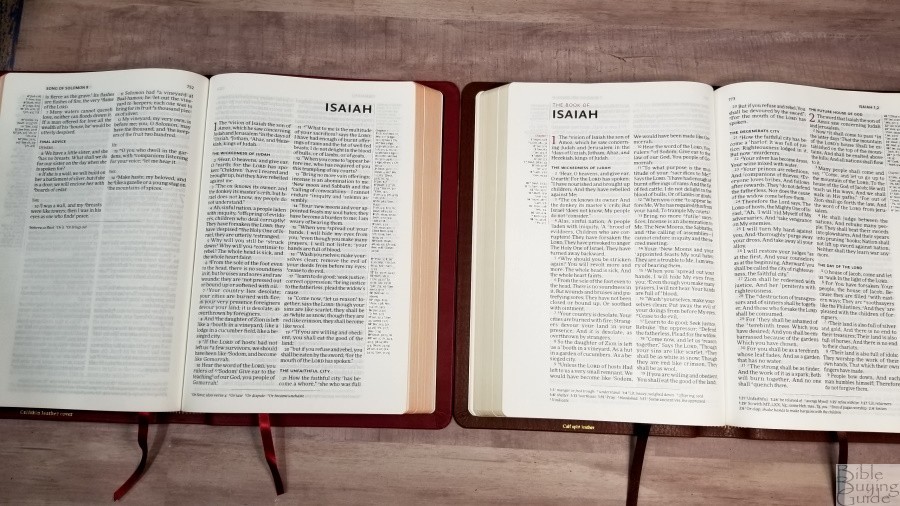

The ESV Topaz matches the NKJV Topaz in every way except it has calfskin instead of calf-split, and the ESV elements such as cross-references, footnotes, section headings, table of weights and measures, and the concordance. The paper, fonts, ribbons, and maps are the same. The ESV’s normal poetic setting doesn’t stand out when placed in a v-b-v format because each new poetic line starts with a lower-case letter instead of an upper-case letter like the NKJV uses.
Quentel
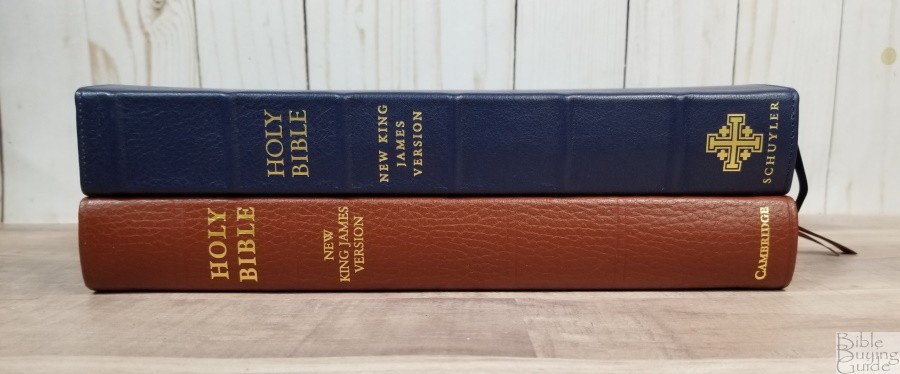
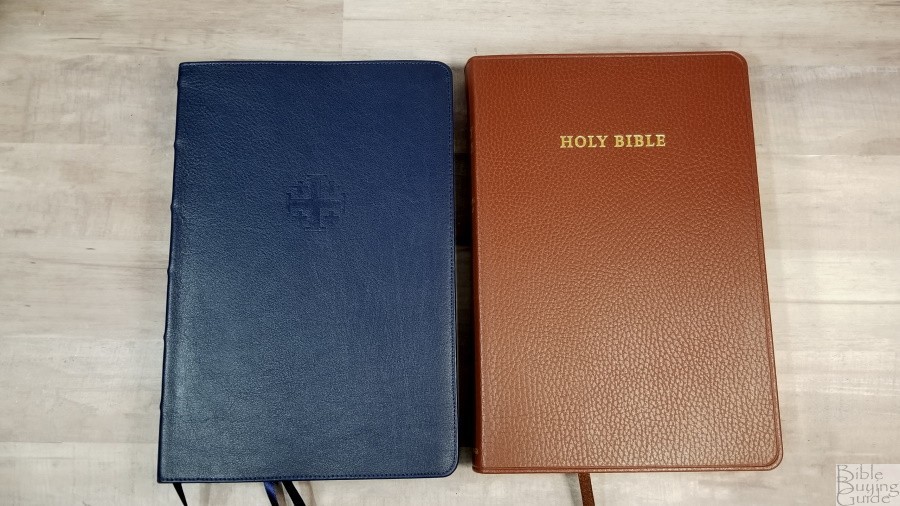
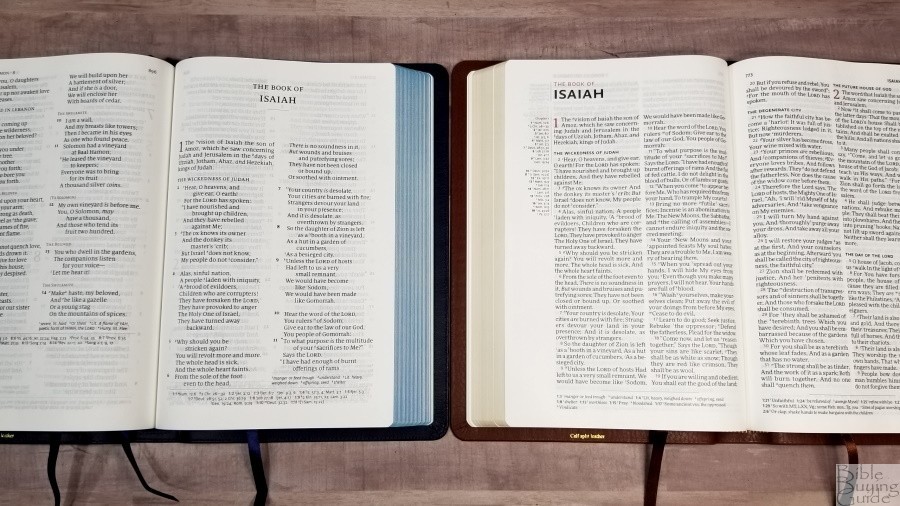
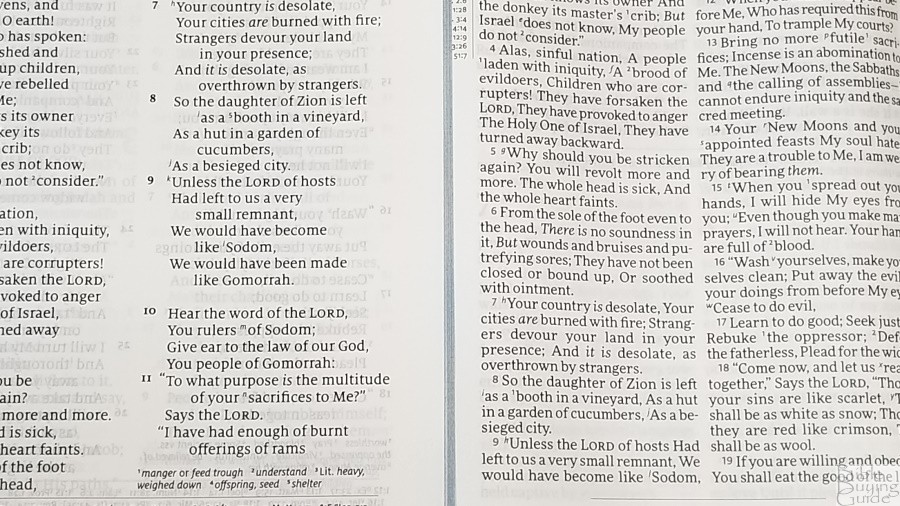
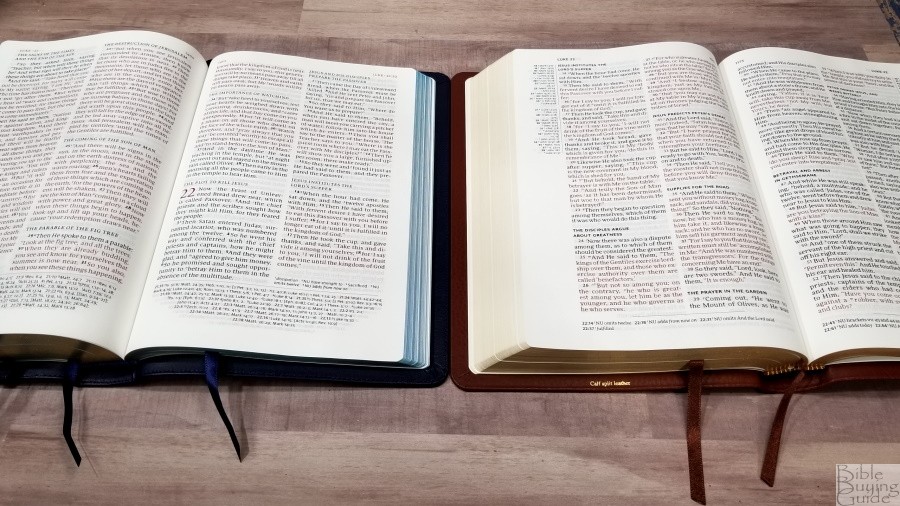
The NKJV Quentel is about the same size as the Topaz. They use the same paper. The Quentel font looks slightly larger with more space between the lines, but the Topaz might be a hair darker for both the black and red letters. The Quentel presents the NKJV text in a double-column paragraph layout and includes more references.
VBV NKJV Premier Collection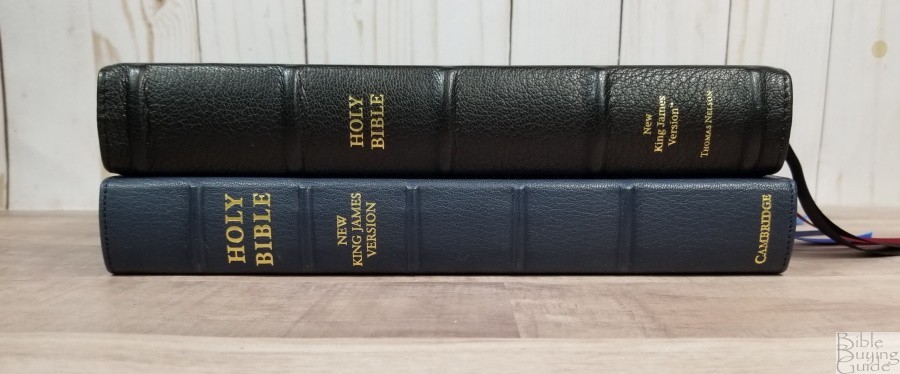
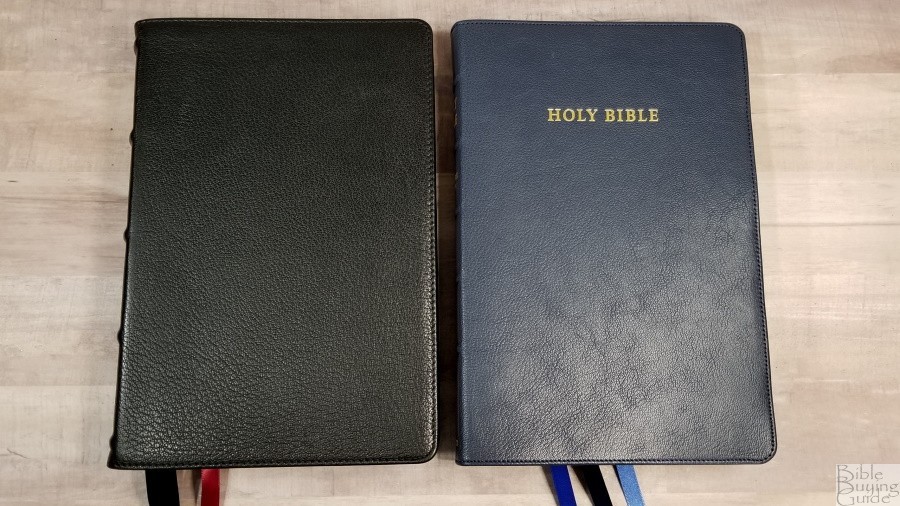
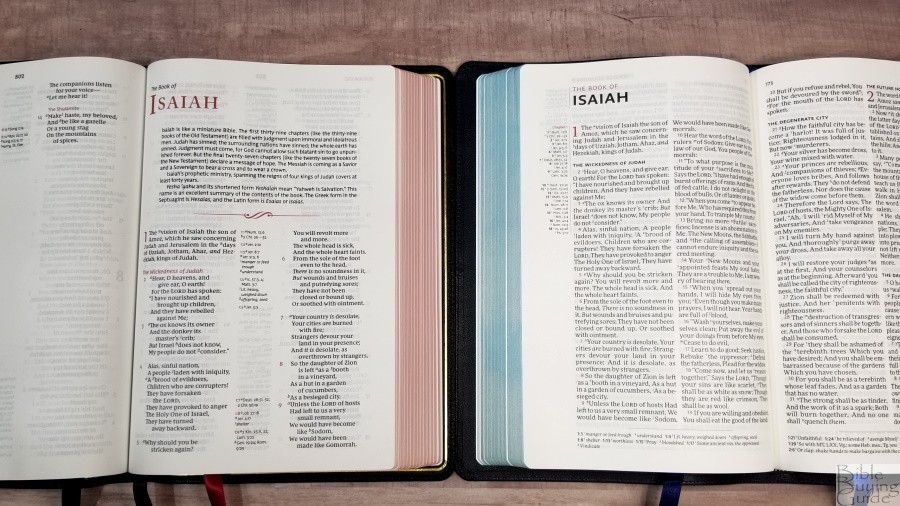
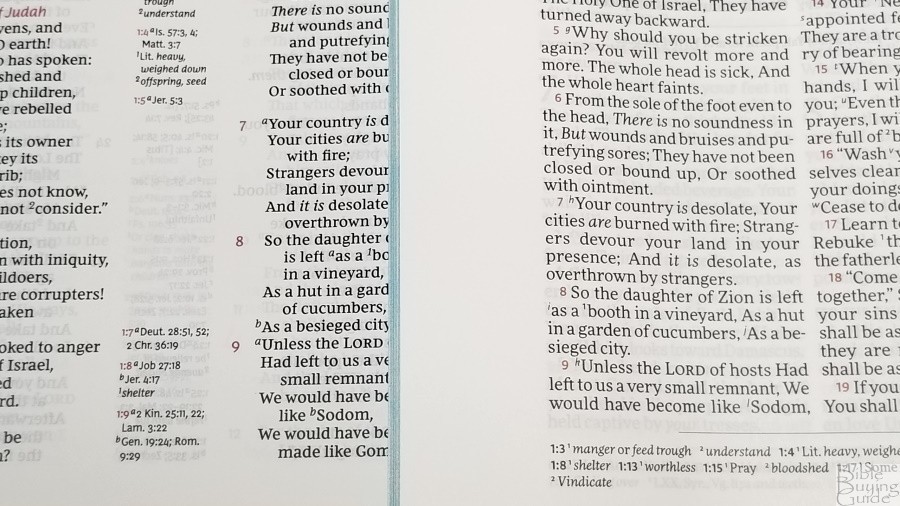
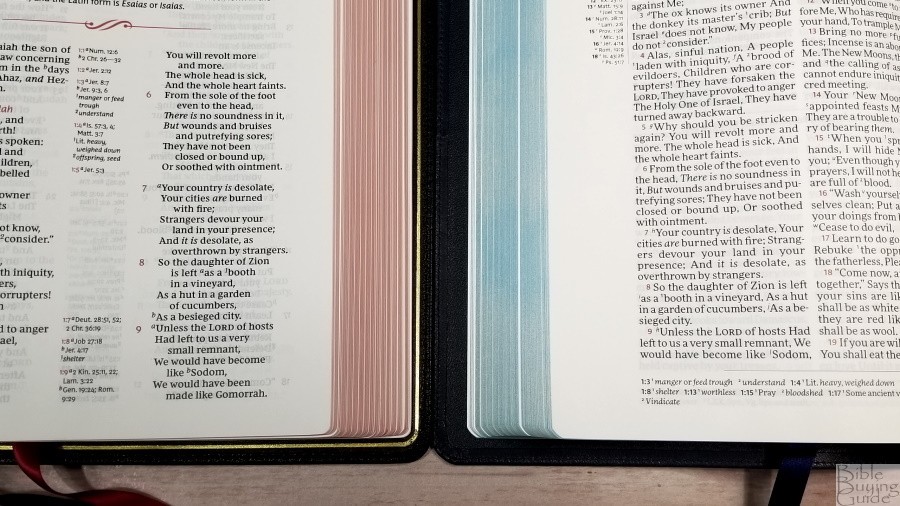
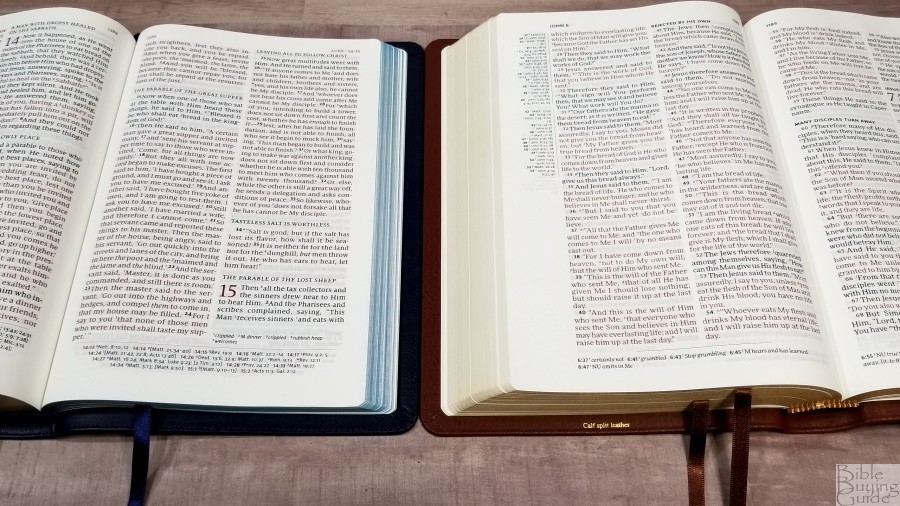
The Thomas Nelson NKJV Verse-by-Verse has the same footprint, but it’s about 1/4″ thicker. It has a v-b-v layout in double-columns, but it retains the poetic setting and indents letters. The font looks to be the same size, but the TN is darker and includes red highlights. It includes book introductions, a concordance, and maps. The Topaz does have higher quality materials and construction, but that’s reflected in the price difference.
NKJV Preaching Bible
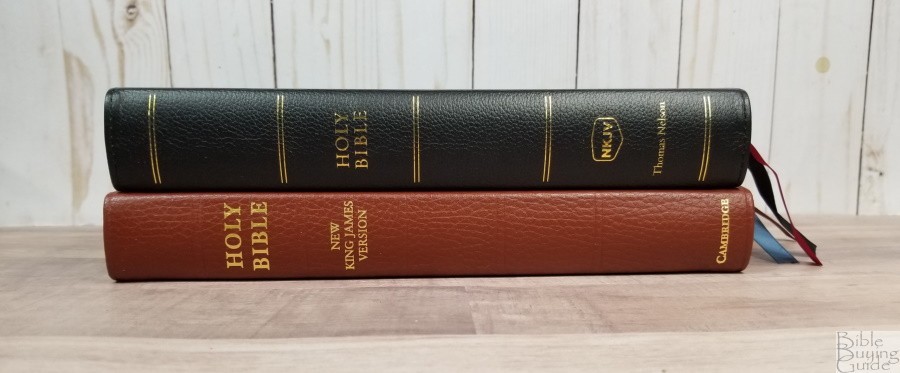

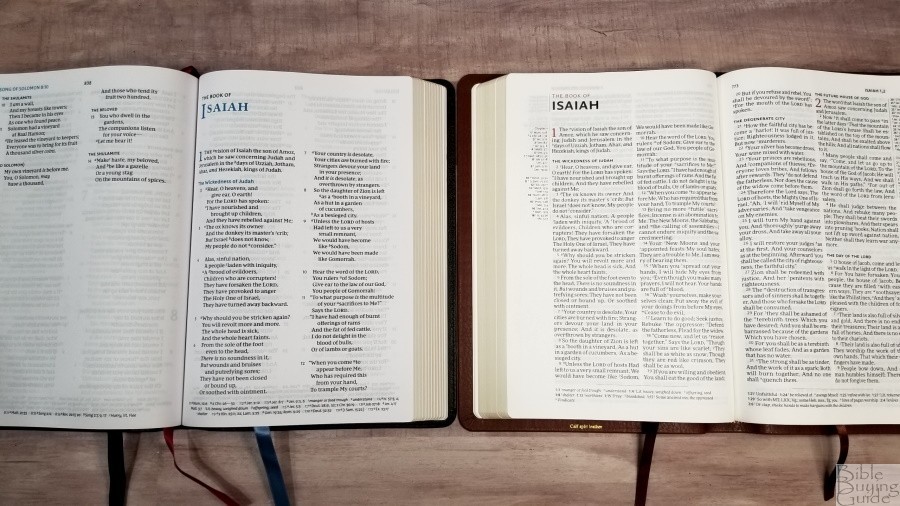
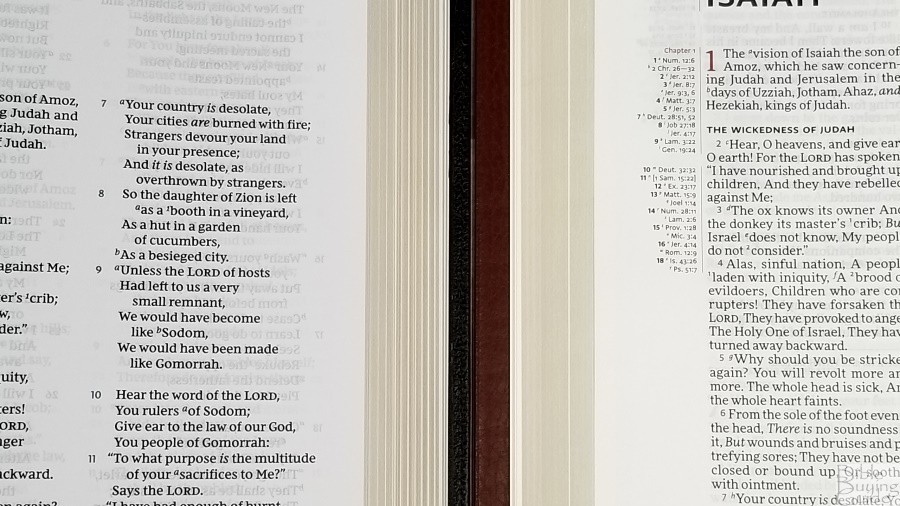
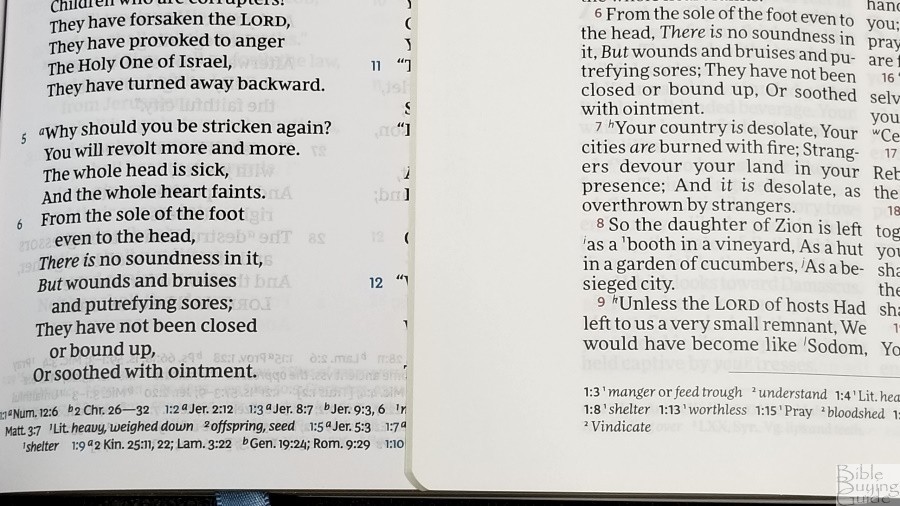
The Thomas Nelson NKJV Preaching Bible was designed with preaching in mind. It has thicker paper and slightly darker font. It’s black-letter, has blue highlights, and has more words per line. It’s a vbv, double-column layout, but poetry is set in stanzas and letters are indented. References and footnotes are combined in the footer. There isn’t a concordance or maps. It has slightly lower quality materials and construction, but that’s reflected in the price difference.
Clarion

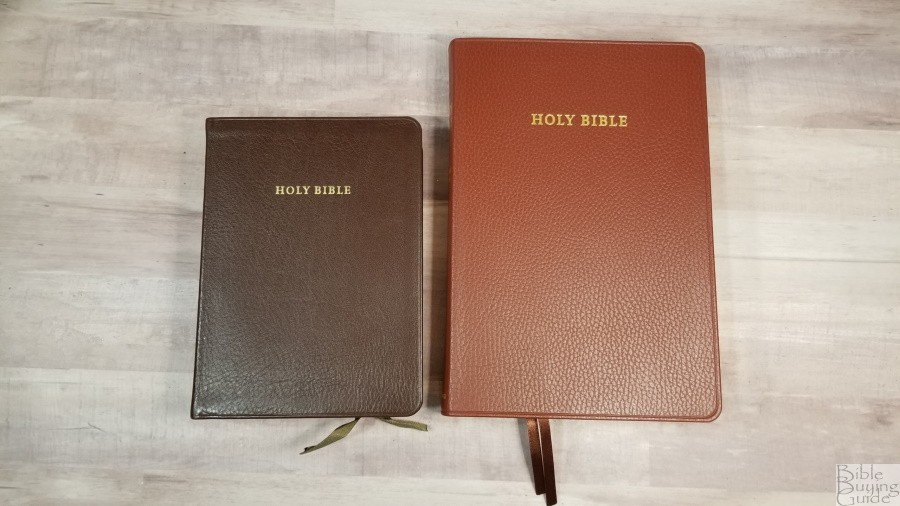
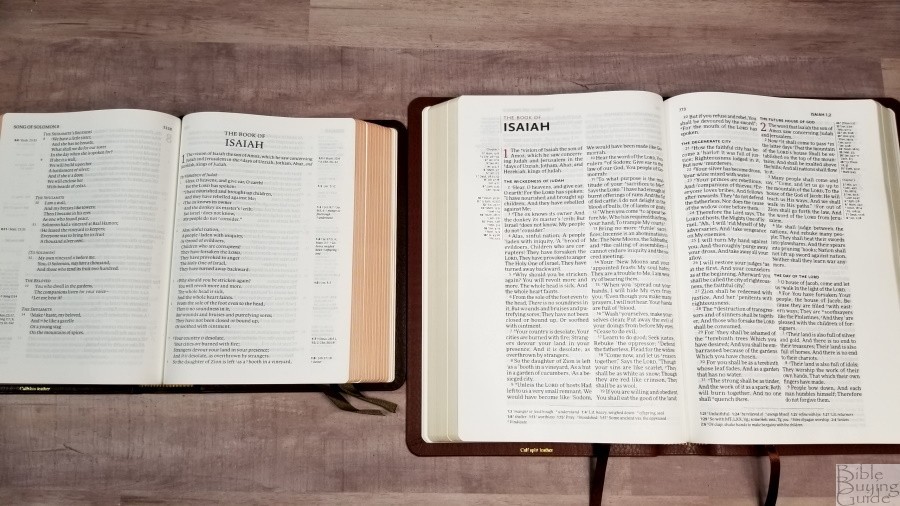

The NKJV Clarion has the same paper, an 8.75 font, a paragraph format with poetry and letters set in a different format, and a lot smaller footprint. It’s noticeably thicker, which many find to be awkward in the hand. It’s designed to be a personal size Bible for carrying and reading. The Clarion has more references, but it also has a smaller concordance. It makes an excellent combo with the Topaz.
Conclusion
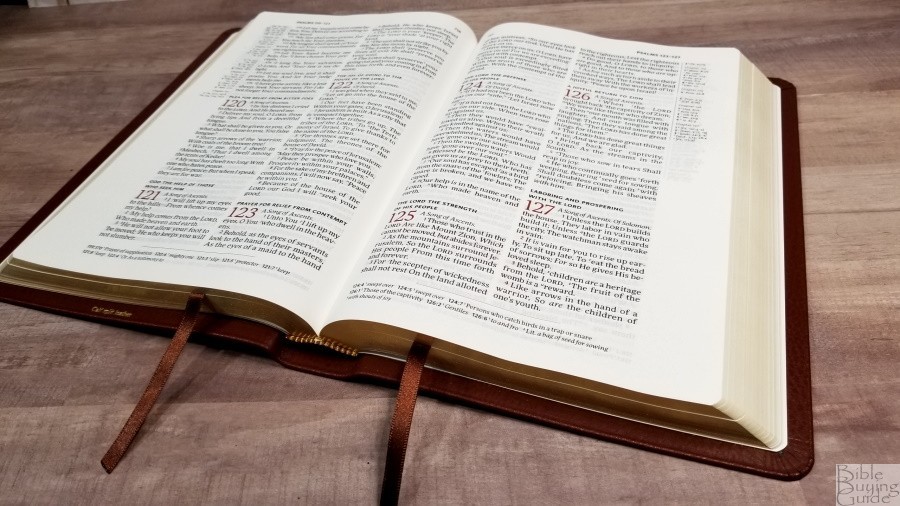
The Cambridge NKJV Topaz Reference Edition is a well-made Bible. As always, Royal Jongbloed has done an excellent job with the high-quality paper, print quality, and bindings. I like both cover options, but I”m actually drawn to the calf-split. I find it easier to hold open to read and it stays open much flatter. It’s reinforced, so it should last for a while. 2K/Denmark has done an excellent job of designing a layout that’s ideal for public reading. The red highlights and red-letter text look elegant.
Some may find a poetic setting difficult to preach from, but I’d like to see the poetic setting added back in. For me, the formatting is one of the advantages of the NKJV- even in a vbv setting. I question why it has fewer cross-references than the NKJV Clarion when it clearly has the space for even more references. Placing the references in the outer margin does help make them easy to use. The larger concordance does help, though. I like that the references and footnotes are separate. I like the design direction to keep the text together and that the text doesn’t run into the gutter.
Similar to the ESV Topaz, MSRP is a little higher than I’d like. Premium Bibles do have higher costs in materials, design, and manufacturing, so I do understand that price, but I hope to see the prices drop over time. I do expect the NKJV Topaz to be a popular edition of the New King James Version. Verse-by-verse is popular and this one delivers. It’s excellent for preaching, teaching, and study. If you’re interested in a high-quality NKJV but don’t want a poetic setting, the NKJV Topaz is a great choice.
_________________________________________________________
This book is available from (contains some affiliate links)
_________________________________________________________
Cambridge provided a discount for the brown Bible and loaned me the blue Bible in exchange for an honest review. I was not required to give a positive review, only an honest one. All opinions are my own.


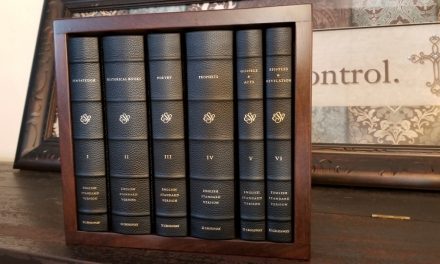
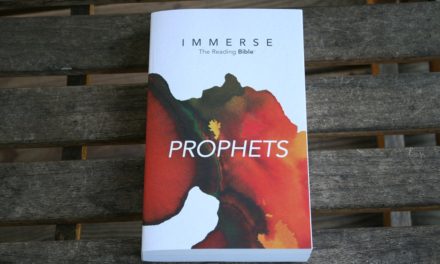
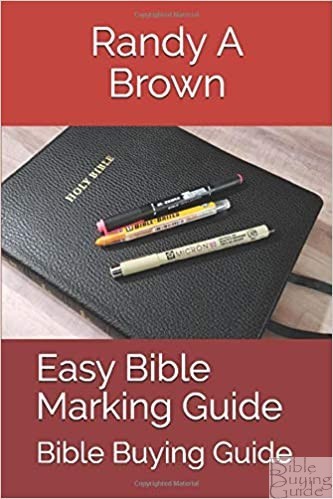
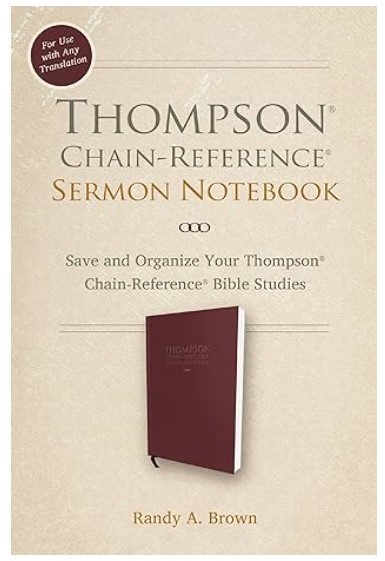



Great review, Randy, as always. I purchased a Cambridge Concord KJV w/thumb indexes last year in black calf-split. This was my first calf-split bible and, like you, I was really pleased with the grain. I also found that it softens up quite nicely with use and feels wonderful in the hand. For this reason, I will probably purchase the brown calf-split Topaz NKJV. And the large concordance is a definite plus!
Thanks!
I don’t care for this layout. There are better offerings from other publishers with better line-spacing too.
And regarding the maps, Cambridge is still pushing the Palestine fable despite the fact that Israel was never called “Palestine” in either Old or New testament times. It wasn’t until 135 A.D. the Roman Emperor Hadrian applied that derogatory term to Judea.
As concerning the Word of life, Luke 10 section 25-28 says: On one occasion an expert in the law stood up to test Jesus. “Teacher,” he asked, “what must I do to inherit eternal life?” “What is written in the Law?” he replied. “How do you read it?” He answered: ” ‘Love the Lord your God with all your heart and with all your soul and with all your strength and with all your mind’; and, ‘Love your neighbor as yourself.'” “You have answered correctly,” Jesus replied. “Do this and you will live.”
Luke 18 section 18-25 says: A certain ruler asked him, “Good teacher, what must I do to inherit eternal life?” “Why do you call me good?” Jesus answered. “No one is good–except God alone. You know the commandments: ‘Do not commit adultery, do not murder, do not steal, do not give false testimony, honor your father and mother.'” “All these I have kept since I was a boy,” he said. When Jesus heard this, he said to him, “You still lack one thing. Sell everything you have and give to the poor, and you will have treasure in heaven. Then come, follow me.” When he heard this, he became very sad, because he was a man of great wealth. Jesus looked at him and said, “How hard it is for the rich to enter the kingdom of God! Indeed, it is easier for a camel to go through the eye of a needle than for a rich man to enter the kingdom of God.”
Matthew 5 section 43-48 says: “You have heard that it was said, ‘Love your neighbor and hate your enemy.’ But I tell you: Love your enemies and pray for those who persecute you, that you may be sons of your Father in heaven. He causes his sun to rise on the evil and the good, and sends rain on the righteous and the unrighteous. If you love those who love you, what reward will you get? Are not even the tax collectors doing that? And if you greet only your brothers, what are you doing more than others? Do not even pagans do that? Be perfect, therefore, as your heavenly Father is perfect.
In Old Testament, the Jewish people and their ancestors were given the Law to observe. First, What Adam and Eve should observe was that they could not eat the fruits from the tree of wisdom. Then, their son Cain was told that he should not kill. As sins became increased, the laws were also added more. Up to the generation of Moses, the Law in Old Testament was given to Israelites. We know that the Law is good and the Law is used to punish people who commit sins, but people cannot obey the Law because the sinful spirits are in people. Even that we know stealing and giving false testimony are sinful, but greedy and pride spirits in us drive us to do sinful things. So as Old Testament prophesied we need to get rid of our sinful nature from our spirits.
Jeremiah 31 section 31-33 says: “The time is coming,” declares the Lord, “when I will make a new covenant with the house of Israel and with the house of Judah. It will not be like the covenant I made with their forefathers when I took them by the hand to lead them out of Egypt, because they broke my covenant, though I was a husband to them,” declares the Lord. “This is the covenant I will make with the house of Israel after that time,” declares the Lord. “I will put my law in their minds and write it on their hearts. I will be their God, and they will be my people.
Ezekiel 36 section 24-27 says: “‘For I will take you out of the nations; I will gather you from all the countries and bring you back into your own land. I will sprinkle clean water on you, and you will be clean; I will cleanse you from all your impurities and from all your idols. I will give you a new heart and put a new spirit in you; I will remove from you your heart of stone and give you a heart of flesh. And I will put my Spirit in you and move you to follow my decrees and be careful to keep my laws.
The prophecies are fulfilled when Jesus begins to teach love. The two greatest commandments are ” ‘Love the Lord your God with all your heart and with all your soul and with all your strength and with all your mind’; and, ‘Love your neighbor as yourself.'” Love is above the Law and if people have love they are free from the law of sin and death. People who are full of love will not think about stealing or giving false testimony but are merciful and they feed hungry people or give thirsty people something to drink or invite strangers in or clothe people who need clothes. The Law is for people who commit sins. Nobody will say that he will get reward because he does not steal before. But love is the grace we get. And with love we will get eternal life.
Romans 13 section 8-10 says: Let no debt remain outstanding, except the continuing debt to love one another, for he who loves his fellowman has fulfilled the law. The commandments, “Do not commit adultery,” “Do not murder,” “Do not steal,” “Do not covet,” and whatever other commandment there may be, are summed up in this one rule: “Love your neighbor as yourself.” Love does no harm to its neighbor. Therefore love is the fulfillment of the law.
Luke 17 section 20-21 says: Once, having been asked by the Pharisees when the kingdom of God would come, Jesus replied, “The kingdom of God does not come with your careful observation, nor will people say,’ Here it is,’ or ‘ There it is,’ because the kingdom of God is within you.”
John 4 section 23-24 says: Yet a time is coming and has now come when the true worshipers will worship the Father in spirit and truth, for they are the kind of worshipers the Father seeks. God is spirit, and his worshipers must worship in spirit and in truth.”
I was wondering if the NKJV Topaz has as many references as the Schuyler NKJV?
It’s astonishing that Cambridge hasn’t revised this yet. Not only is the formatting wrong, but it’s grammatically incorrect to capitalize a word mid-sentence unless it’s a proper noun. Why is retypsetting this not a priority?